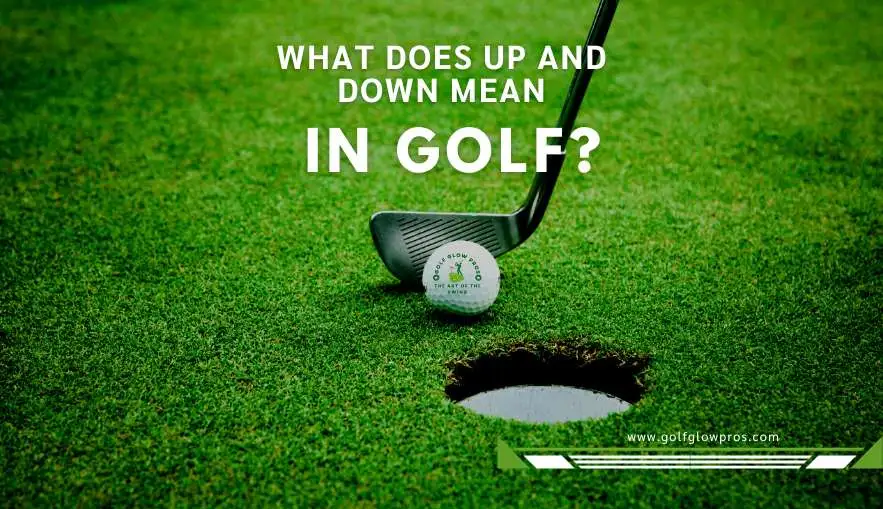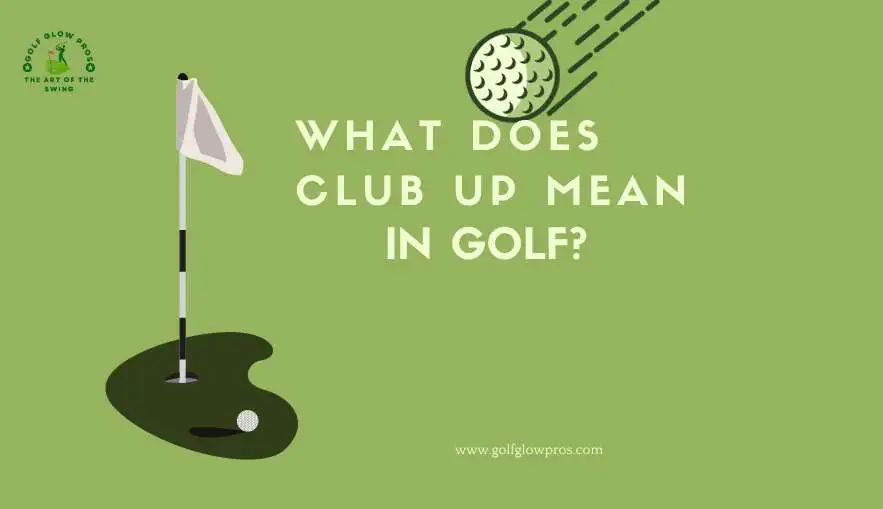What Does Club Up Mean in Golf? Let’s know everything, In golf, “clubbing up” simply means choosing a club with more loft or distance capability to account for different factors on the course. Let’s dissect it.
Imagine you’re on the fairway, and the wind is blowing against you, as if nature is saying, “Hey, maybe go for a club with a bit more oomph.”
So you decide to club up, selecting a club that can withstand the additional push from the wind. Imagine you’re facing a longer-than-usual shot and decide, “Time to bring out the big guns!”
When you club up, you ensure that your ball reaches its destination without breaking a sweat. It’s essentially a strategic move, a golfing decision made by golfers to adapt to course conditions and get the ball where it needs to go.
So, the next time you hear someone say, “I think I’ll club up for this one,” you’ll know they’re not referring to an exclusive golf-themed social club – they’re simply making a wise decision on the course.
What Does Club Down in Golf?
Okay, imagine you’re on the golf course with your bag full of clubs. In golf, “clubbing down” simply means selecting a club with less loft or a lower number.
Assume you normally use your trusty 7-iron, but the wind is really picking up.In that case, a 5-iron or even a 4-iron should suffice. Because these clubs have less loft, the ball will fly lower and be less affected by the wind.
Clubbing down is the way to go if you find yourself in a tight fairway or need to hit the ball a shorter distance. Using a club with greater distance control, such as a 9-iron instead of a 7-iron, can help you fine-tune that shot.
Consider this you’re standing on the tee, and there’s a water hazard not far away. Clubbing down to a hybrid or a fairway wood may be the best option for you. These clubs can provide greater accuracy and assist you in avoiding trouble.
In the simplest terms, clubbing down in golf is analogous to selecting the proper tool for the job. It’s all about selecting the right club for the situation, whether it’s dealing with wind, navigating a difficult course, or avoiding hazards.
So, the next time you’re out on the course, keep in mind that sometimes less is more – club down and play smart!
Is it Better to Club Up Or Down?
Choosing whether to use a higher or lower-numbered club on the golf course can make a big difference in your game. Consider this: you’re standing on the tee, and the fairway spreads out in front of you.
Let’s break it down now. If you want the ball to fly higher and farther, use a club with a higher number, such as a 7 iron.
Choose a lower-numbered club, such as a 3-wood, if you need more distance and a lower trajectory.
Changing clubs is like choosing the right tool for the job; each one serves a specific purpose. So, what’s the point?
Consider it like having a toolkit with various wrench sizes. You wouldn’t use a big one for a small bolt, would you?
Similarly, picking the right club is like selecting the best tool for the job. Furthermore, taking into account the terrain is critical. If there is a hazard or obstacle, using a club with more loft can assist you in clearing it club up, meaning in golf.
On the other hand, if the fairway is wide open, using a lower-numbered club can increase your distance. It’s similar to navigating different challenges on the golf course – adaptability is essential.
Weather conditions also play a role. Wind can be a friend or a foe. Using a higher-numbered club in the wind can help you control the ball better while using a lower-numbered club with the wind at your back can help you gain some extra yards.
It’s essentially the same as changing your strategy based on the weather forecast. To summarize, understanding the situation – the distance, the terrain, and the weather – determines whether to club up or down in golf.
Each shot is like a puzzle, and mastering this skill can truly elevate your golf game.
How Do You Get A Golf Club Up?
Please, yes! Simply follow these simple steps to set up a golf club. First, take a firm but not overly tight grip on the club with both hands.
Next, stand shoulder-width apart and hold the club in front of you, pointing towards the target.
Swing the club back while keeping your gaze on the ball, taking a deep breath. As you swing, shift your weight to your back foot to create a smooth transition.
Transitioning is essential for a powerful and precise swing.
When you reach the backswing, shift your weight forward onto your front foot smoothly.
This motion is critical for producing power and control in your shot. Maintain your gaze on the ball throughout the motion.
As you transition to the downswing, let your hips lead the way. This aids in the development of a natural and effective movement sequence club mean in golf.
Don’t rush the downswing; a smooth and controlled downswing is essential for a successful shot.
Keep your arms extended and your wrists tight as you make contact with the ball. The transition from backswing to downswing should be smooth for maximum impact.
Following through with your swing is equally important, so allow your body to naturally rotate after contact.
To summarize, picking up a golf club requires a series of smooth transitions and controlled movements.
Maintain a relaxed grip, concentrate on weight transfer, and allow your body to flow through the swing. You’ll be able to hit the ball with confidence and precision with time and practice.
What Does Up and Down Mean in Golf?
The terms “up” and “down” in golf may sound like they’re talking about directions, but they’re actually talking about the number of strokes it takes to complete a hole.
Consider yourself on the green, attempting to sink the ball into the small hole in as few strokes as possible.
When someone says they’re “up,” it means they finished the hole in fewer strokes than the expected or average number of strokes.
It’s almost like a victory dance on the green. When golfers say they’re “down,” it means they’ve taken more strokes than the expected number for that hole.
It’s not as upbeat as “Up,” but everyone on the course has bad days.
Let’s take it a step further. Consider yourself on a par-3 hole. The par is the number of strokes required for an expert golfer to complete the hole.

If you get the ball in the hole in two strokes, you’re “up” by one. At that point, you’re basically golf MVP material.
If it takes you four strokes to sink that little white ball, you are “down” by one. It’s not the end of the world, but you need to catch up.
Moving on, these terms are important in golf jargon because they reflect a player’s performance in relation to the expected standard for each hole club up mean in golf.
It’s like a golfer’s secret code, a way of saying, “I aced that hole” or “Well, that didn’t go as planned.”
If you consistently find yourself “up,” you’re probably on cloud nine, feeling like the Tiger Woods of your local course.
However, if you are frequently “down,” don’t worry. Even the pros experience ups and downs when playing golf. It’s all part of the learning process for swinging clubs and putting like a pro.
Finally, whether you’re doing well or poorly on the golf course, the most important thing is to have fun. Every swing and putt is part of the adventure.
So, the next time you hear someone say they’re up or down in golf, you’ll know they’re not giving you directions, but rather sharing their victories or challenges on the green. Have a great time golfing!
Do You Club Up Or Down From Elevated Tee?
Choosing whether to club up or down from an elevated tee is a common golfer’s quandary. Consider yourself high above the fairway, scanning the landscape for the pin. Here’s the lowdown on making the best decision.
First and foremost, consider the yardage. Consider adding an extra club to your arsenal if the flag is lurking uphill. Why, you might ask? Because elevation can eat up some of the distance of your shot.
When faced with a downhill challenge, consider downshifting your club selection. Why? Gravity becomes your golf partner, assisting your ball in covering more ground than usual.
Let’s talk about wind before we move on. It’s not just a gentle breeze; it’s a game changer. If it’s in your face, choose a more robust club. Consider a lighter companion if it’s at your back.
Consider the complexities of the green. An elevated tee usually indicates a different angle of attack. Consider your ball to be a plane attempting to stick the landing—adjust accordingly.

Let’s talk about confidence once more as we transition. If you’re not feeling like Tiger Woods on that particular day, raise your club selection a notch. On the golf course, confidence is your secret sauce club up mean in golf.
Finally, when you’re on an elevated tee, be the master of club selection. Calculate the yardage, take the slope into account, dance with the wind, navigate the green, and let confidence be your caddy. Make it a swing to remember, whether you choose to club up or down!
Should You Club Up Or Down in Wind?
Assume you’re on the golf course, and the wind begins to play its own game. The deal is that choosing the right club in the wind can make or break your shot.
First and foremost, the wind blowing against you is nature’s way of saying, “Hey, I’m here to mess with your ball.” So, what are you going to do? You must think wisely and select a club with more muscle.
Choose a club with more oomph, such as a 3-wood or even a hybrid. These clubs cut like a hot knife through butter through the wind.
When the wind becomes your golf buddy and blows in the same direction as your shot, it’s like getting a little boost from nature.
In this situation, be the wise golfer and select a club with less power. Choose a loftier club, such as a 7-iron or a pitching wedge. These babies will ride the wind, allowing your ball to soar club up mean in golf.
But, hey, the wind can be tricky at times, swirling around like it’s doing a dance. It’s time to unleash your inner meteorologist.
Pay attention to the course flags; they’re Mother Nature’s way of dropping hints. Lean towards a stronger club if the flag is standing at attention, indicating a strong breeze.
If it’s fluttering gently and teasing the air, choose a gentler club.
So, depending on how you play, the wind can be your golf nemesis or your secret ally.
Remember to beef up your club selection when the odds are stacked against you, and dial it back when the odds are on your side.
Mother Nature may throw a curveball, but with the right club, even in windy conditions, you can hit a hole-in-one. Do you clear about What Does Club Up Mean in Golf?
What is A Call Up in Golf and What Does Club Up Mean in Golf?
A “call-up” in golf is like receiving an unexpected invitation to the cool kids’ table. Imagine you’re out on the course, enjoying the fresh air when the golf gods decide it’s your turn to shine.
It’s almost as if you’re having a surprise party for your abilities! Let us now break it down.
When you’re playing in a group, a call-up occurs when your ball is closest to the hole after everyone else has taken their shots.
It’s similar to winning a mini-contest within your game, a friendly competition between friends.
So, you’re walking down the fairway when BAM! You are the centre of attention. Your buddies give you the thumbs up, and you become the golf VIP for the day.
It’s time to show off your swing and make the rest of the group jealous of your golf skills.
Going from a casual conversation to a sudden golf match may feel like going from 0 to 60 in a split second, but that’s the beauty of a call-up club in golf.
It adds a spark to your round, transforming an ordinary day on the course into a memorable highlight reel.
Don’t get too worked up. Accept your call-up like a champion. Step confidently up to the ball, channel your inner golf maestro, and give it your all.
It’s your chance to outshine your friends and take pride in being the closest to the pin.
Remember that a call-up is about more than just skill; it’s about seizing the moment.
It’s like getting a lucky break in the middle of your golf adventure, a bonus round where you can show off your skills and possibly win a trophy for bragging rights.
So, the next time you hear “You’re up,” get ready to swing into action.
A call-up is your ticket to golf stardom within your group, your chance to make your friends applaud your shot and possibly tip their imaginary hats to your newfound golfing glory.
What Does Open Club Face Mean?
Yes, please! Let’s break down the concept of an open club face in golf in a conversational and simple manner.
Consider yourself on the golf course, ready to take your shot.
An open club face is when your clubface points slightly to the right for a right-handed golfer or slightly to the left for a left-handed golfer.
“I want to go that way!” your club seems to be saying.
To get down to business, this occurs when the leading edge of the clubface is turned away from the target.
Assume you’re shaking hands with someone, and your palm is facing the sky rather than the person. That’s the deal with an open club face: it’s as if your club is waving to you from the side.
So, what’s the point? When your club face is open, the ball will veer off course and not go where you want it to.
It’s like trying to throw a frisbee straight, and it decides to deviate instead. Isn’t that awful?
Now comes the fun part: figuring out how to fix it!
Imagine you’re holding a pizza box to square up your club face. You want to rotate it precisely so that it is pointing straight at your target.
Apply the same logic to your club face to direct the ball where you want it to go.
In short, an open club face is similar to your club experiencing a slight twist, and it can interfere with your shot direction.
But don’t worry! You can get that club face pointing in the right direction and send that ball exactly where you want it to go with a little tweaking. Have fun swinging! I think you understand about What Does Club Up Mean in Golf.












